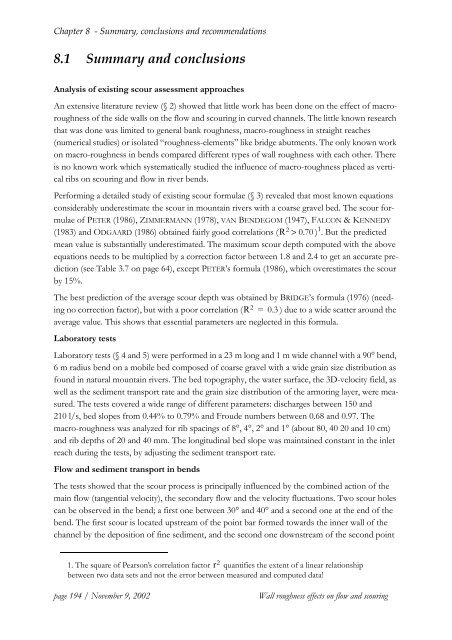pdf, 12 MiB - Infoscience - EPFL
pdf, 12 MiB - Infoscience - EPFL
pdf, 12 MiB - Infoscience - EPFL
You also want an ePaper? Increase the reach of your titles
YUMPU automatically turns print PDFs into web optimized ePapers that Google loves.
Chapter 8 - Summary, conclusions and recommendations<br />
8.1 Summary and conclusions<br />
Analysis of existing scour assessment approaches<br />
An extensive literature review (§ 2) showed that little work has been done on the effect of macroroughness<br />
of the side walls on the flow and scouring in curved channels. The little known research<br />
that was done was limited to general bank roughness, macro-roughness in straight reaches<br />
(numerical studies) or isolated “roughness-elements” like bridge abutments. The only known work<br />
on macro-roughness in bends compared different types of wall roughness with each other. There<br />
is no known work which systematically studied the influence of macro-roughness placed as vertical<br />
ribs on scouring and flow in river bends.<br />
Performing a detailed study of existing scour formulae (§ 3) revealed that most known equations<br />
considerably underestimate the scour in mountain rivers with a coarse gravel bed. The scour formulae<br />
of PETER (1986), ZIMMERMANN (1978), VAN BENDEGOM (1947), FALCON & KENNEDY<br />
(1983) and ODGAARD (1986) obtained fairly good correlations ( R 2 > 0.70 ) 1 . But the predicted<br />
mean value is substantially underestimated. The maximum scour depth computed with the above<br />
equations needs to be multiplied by a correction factor between 1.8 and 2.4 to get an accurate prediction<br />
(see Table 3.7 on page 64), except PETER’s formula (1986), which overestimates the scour<br />
by 15%.<br />
The best prediction of the average scour depth was obtained by BRIDGE’s formula (1976) (needing<br />
no correction factor), but with a poor correlation ( R 2 = 0.3 ) due to a wide scatter around the<br />
average value. This shows that essential parameters are neglected in this formula.<br />
Laboratory tests<br />
Laboratory tests (§ 4 and 5) were performed in a 23 m long and 1 m wide channel with a 90° bend,<br />
6 m radius bend on a mobile bed composed of coarse gravel with a wide grain size distribution as<br />
found in natural mountain rivers. The bed topography, the water surface, the 3D-velocity field, as<br />
well as the sediment transport rate and the grain size distribution of the armoring layer, were measured.<br />
The tests covered a wide range of different parameters: discharges between 150 and<br />
210 l/s, bed slopes from 0.44% to 0.79% and Froude numbers between 0.68 and 0.97. The<br />
macro-roughness was analyzed for rib spacings of 8°, 4°, 2° and 1° (about 80, 40 20 and 10 cm)<br />
and rib depths of 20 and 40 mm. The longitudinal bed slope was maintained constant in the inlet<br />
reach during the tests, by adjusting the sediment transport rate.<br />
Flow and sediment transport in bends<br />
The tests showed that the scour process is principally influenced by the combined action of the<br />
main flow (tangential velocity), the secondary flow and the velocity fluctuations. Two scour holes<br />
can be observed in the bend; a first one between 30° and 40° and a second one at the end of the<br />
bend. The first scour is located upstream of the point bar formed towards the inner wall of the<br />
channel by the deposition of fine sediment, and the second one downstream of the second point<br />
1. The square of Pearson’s correlation factor r 2 quantifies the extent of a linear relationship<br />
between two data sets and not the error between measured and computed data!<br />
page 194 / November 9, 2002<br />
Wall roughness effects on flow and scouring
















